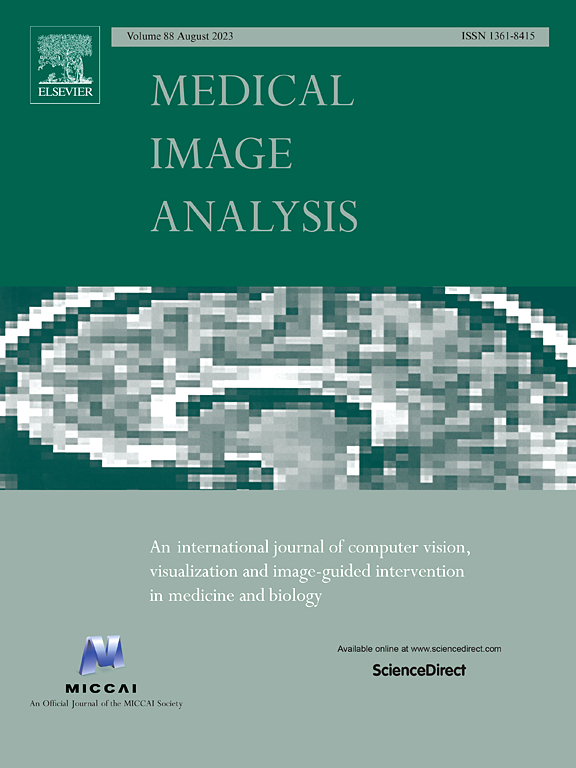Semi-supervised ViT knowledge distillation network with style transfer normalization for colorectal liver metastases survival prediction
IF 10.7
1区 医学
Q1 COMPUTER SCIENCE, ARTIFICIAL INTELLIGENCE
引用次数: 0
Abstract
Colorectal liver metastases (CLM) affect almost half of all colon cancer patients and the response to systemic chemotherapy plays a crucial role in patient survival. While oncologists typically use tumor grading scores, such as tumor regression grade (TRG), to establish an accurate prognosis on patient outcomes, including overall survival (OS) and time-to-recurrence (TTR), these traditional methods have several limitations. They are subjective, time-consuming, and require extensive expertise, which limits their scalability and reliability. Additionally, existing approaches for prognosis prediction using machine learning mostly rely on radiological imaging data, but recently histological images have been shown to be relevant for survival predictions by allowing to fully capture the complex microenvironmental and cellular characteristics of the tumor. To address these limitations, we propose an end-to-end approach for automated prognosis prediction using histology slides stained with Hematoxylin and Eosin (H&E) and Hematoxylin Phloxine Saffron (HPS). We first employ a Generative Adversarial Network (GAN) for slide normalization to reduce staining variations and improve the overall quality of the images that are used as input to our prediction pipeline. We propose a semi-supervised model to perform tissue classification from sparse annotations, producing segmentation and feature maps. Specifically, we use an attention-based approach that weighs the importance of different slide regions in producing the final classification results. Finally, we exploit the extracted features for the metastatic nodules and surrounding tissue to train a prognosis model. In parallel, we train a vision Transformer model in a knowledge distillation framework to replicate and enhance the performance of the prognosis prediction. We evaluate our approach on an in-house clinical dataset of 258 CLM patients, achieving superior performance compared to other comparative models with a c-index of 0.804 (0.014) for OS and 0.735 (0.016) for TTR, as well as on two public datasets. The proposed approach achieves an accuracy of 86.9% to 90.3% in predicting TRG dichotomization. For the 3-class TRG classification task, the proposed approach yields an accuracy of 78.5% to 82.1%, outperforming the comparative methods. Our proposed pipeline can provide automated prognosis for pathologists and oncologists, and can greatly promote precision medicine progress in managing CLM patients.
半监督 ViT 知识蒸馏网络与风格转移归一化用于结直肠肝转移生存率预测
结直肠肝转移(CLM)影响着近一半的结肠癌患者,对全身化疗的反应对患者的生存起着至关重要的作用。虽然肿瘤学家通常使用肿瘤分级评分(如肿瘤回归分级(TRG))来准确预测患者的预后,包括总生存期(OS)和复发时间(TTR),但这些传统方法存在一些局限性。它们主观、耗时,需要大量的专业知识,这限制了它们的可扩展性和可靠性。此外,利用机器学习进行预后预测的现有方法大多依赖于放射成像数据,但最近的研究表明,组织学图像可以充分捕捉肿瘤复杂的微环境和细胞特征,因此与生存预测相关。为了解决这些局限性,我们提出了一种端到端方法,利用经苏木精和伊红(H&E)及红花苷(HPS)染色的组织学切片进行自动预后预测。我们首先采用生成对抗网络(GAN)对玻片进行归一化处理,以减少染色差异,提高作为预测管道输入的图像的整体质量。我们提出了一种半监督模型,从稀疏注释中进行组织分类,生成分割图和特征图。具体来说,我们使用一种基于注意力的方法,在生成最终分类结果时权衡不同切片区域的重要性。最后,我们利用提取的转移结节和周围组织特征来训练预后模型。与此同时,我们还在知识提炼框架中训练了一个视觉转换器模型,以复制和提高预后预测的性能。我们在一个包含 258 名 CLM 患者的内部临床数据集上对我们的方法进行了评估,与其他比较模型相比,我们的方法取得了优异的性能,OS 的 c 指数为 0.804 (0.014),TTR 为 0.735 (0.016),同时我们还在两个公共数据集上对我们的方法进行了评估。所提出的方法在预测 TRG 二分法方面达到了 86.9% 到 90.3% 的准确率。对于 TRG 的三类分类任务,所提出的方法获得了 78.5% 至 82.1% 的准确率,优于其他比较方法。我们提出的方法可以为病理学家和肿瘤学家提供自动预后分析,并能极大地促进精准医疗在管理CLM患者方面的进展。
本文章由计算机程序翻译,如有差异,请以英文原文为准。
求助全文
约1分钟内获得全文
求助全文
来源期刊

Medical image analysis
工程技术-工程:生物医学
CiteScore
22.10
自引率
6.40%
发文量
309
审稿时长
6.6 months
期刊介绍:
Medical Image Analysis serves as a platform for sharing new research findings in the realm of medical and biological image analysis, with a focus on applications of computer vision, virtual reality, and robotics to biomedical imaging challenges. The journal prioritizes the publication of high-quality, original papers contributing to the fundamental science of processing, analyzing, and utilizing medical and biological images. It welcomes approaches utilizing biomedical image datasets across all spatial scales, from molecular/cellular imaging to tissue/organ imaging.
 求助内容:
求助内容: 应助结果提醒方式:
应助结果提醒方式:


